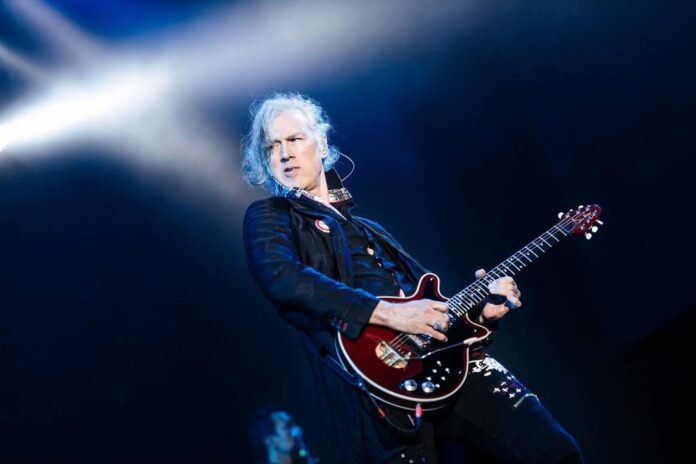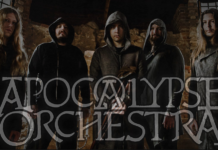Pic: SevenArt
This article series is about the tools of popular guitarists. What are their favorite guitars and how is it related to them? This time with with Tristan Avakian (Killer Kings, One Vision Of Queen starring Marc Martel).
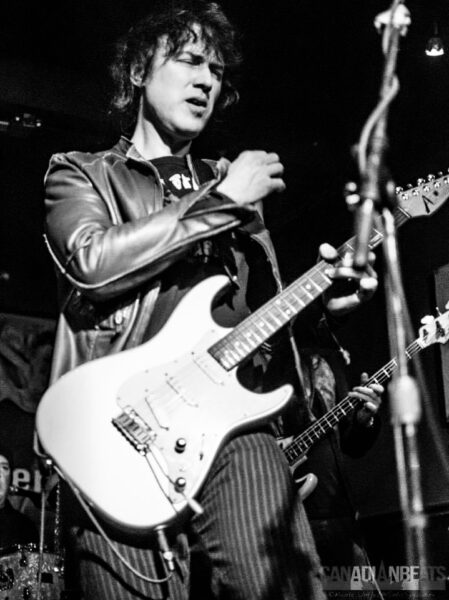
When did you start playing, and do you remember your first guitar?
When I was 12, I had a nylon string acoustic. I taped a penny to the bridge so it would rattle – the closest I could get to a fuzz tone! Hilarious.
Later I got a cheap Teisco for $25. Saved up for a Mustang and smashed the Teisco at my first gig, like an asshole – I could probably sell it to a hipster for a thousand dollars, now.
To this day, I believe that good tone need not be expensive or rare, as the rest of this interview will reveal.
What are your influences and which guitar players are your faves?
Hendrix, Jimmy Page, Robin Trower and Richie Blackmore were my early influences. Hendrix and Page, especially, were everything for a while. I’d lifted a lot of the first Zeppelin record by the time I was 14.
I love Van Halen but avoided him, because a lot of players jumped on the tapping thing right away. To this day, I only use it when there’s no other way for me to execute a specific musical idea clearly. To me, the best thing about him is his swing and his beautiful recklessness. People tend to focus on his technical skills and that’s only part of it.
I had heard Brian May on the radio, and was amazed, but I ruled him out. Sounded like magic to me, thought to myself, „I better do something else“. Later in life, he hired me to do exactly that, and it’s perhaps what I’m best known for, ironically.
I was lucky enough to know Steve Stevens and Steve Vai as a snot nosed kid. They were already fully realized master musicians with a distinctive look and style, and incredible discipline. I got a couple of lessons from Vai for $10 an hour! And Stevens turned me on to a lot of good music.
To this day, I sometimes think „What would SS do, here?“ And I just do that.
There are unsung heroes who never went mainstream but were revered on the New York scene, who I looked up to – like Paul Pesco, Hiram Bullock, Mark Hitt, Ira Siegel… and especially Ronny „Head“ Drayton, who saw something in me and took me under his wing, against his better judgement, I’m sure. I still miss him. A giant of a musician, a monster guitar player with an unmistakable sound, and a huge heart.
Other influences along the way have been Townsend, Steve Jones, Keith Richards. Bowie’s guitarists, notably Mick Ronson and Adrian Belew. Lynch, DiMartini. Absolute gods such as Allan Holdsworth and Mike Stern have to be mentioned. And I’m delving into Django Reinhardt now – better late than never.
I never stop learning. Living in Nashville affords me the opportunity to see a monster player any night of the week, and I take it, frequently. Guthrie Trapp plays every Monday, and he’s mindblowing.
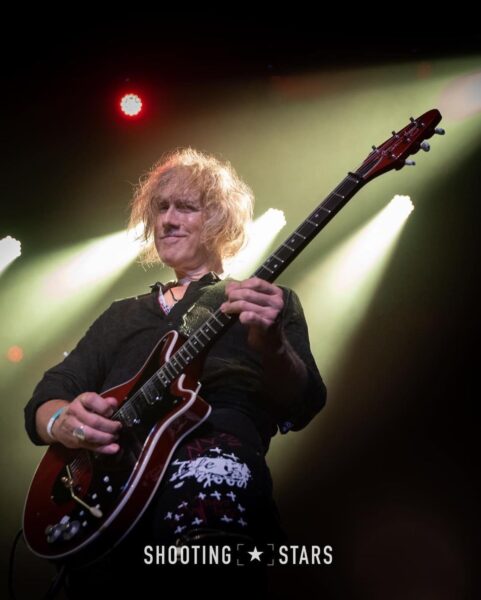
How many guitars do you own and what are your favorite models?
About 21. I haven’t counted lately. I like to be versatile, so they run the gamut. Not much room for redundancy. Some are so weird that they don’t get played often.
The Tom Anderson Classic is my go-to – it’s like part of my body and it’s crazy how versatile and expressive it is. I consider the Stratocaster to be the logical endpoint of electric guitar design. And Tom perfected it – took it the rest of the way. It is so ergonomic that it disappears in your hands and becomes one with you. I don’t think when I’m playing it, any more than I think about speaking. It’s that good.
He lent it to me after NAMM 2005 for a few days – it was on display in his booth. I fell in love with it, and wanted to buy it outright. He said, „sure you don’t want me to build you one? Keep it a few days and then decide“.
I took it to a record session at SIR the next day. The producer was a friend of mine, so during a break I turned it up and wound it out, playing my Strat test licks – Hendrix stuff from the first album, mostly – while he went out to the lounge. He came back in a while and said, „Hey, guess who’s outside listening? (insert famous guitar player name here)“. I said, „well, shit! Invite him in!“ He goes back outside. Comes back in, alone. Says, „he just went… ’nah. That’s alright‘, and he left… looked kinda worried“.
I called Tom on the spot and said „I’LL TAKE IT!!!“ Haha.
And it only gets better with time.
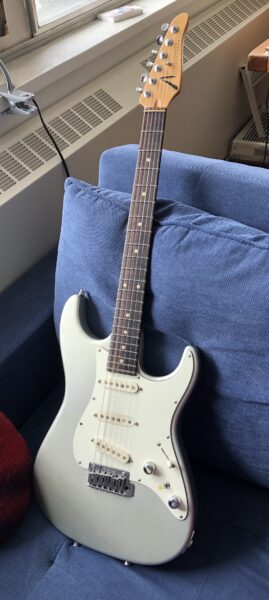
Second would be the 1991 Les Paul Standard. It’s black, and doesn’t look like much. A little on the heavy side at 9 lbs. Weight relieved, no premium features like light mahogany or long tenon construction. Just a regular mass produced Gibson. But it was a comeback year – they were making good guitars again – and Aerosmith was ruling with „Pump“… I had to have a black Standard like Perry’s.
I went to the showroom in Times Square – I knew Jimmy Archey, the artist rep, and was working on a major label album, which helped – played all of them, and picked the best one. Asked Jimmy to hold it a few days while I got the money together (artist price was $400, still a lot of bread for me). He called me two days later to tell me „Joe Perry is here, and he wants a ’signer‘ (a giveaway guitar for autographs). You better get here soon or it’s gone!“ I came up with the money in a half hour! No way was that guitar gonna end up on a wall.
It’s a good one. Dead stable tuning after I replaced the „tulip“ tuners with Grovers, and still stable all these years later – even after the headstock was broken and repaired twice (I had a brief Cobain phase). All the frequencies, acoustically, all the way up and down the neck. After a couple of pickup changes, I settled on Manlius Fat Dianes, which are PAF repros, and aptly named. Very responsive to playing dynamics, nice note „bloom“. I get everything I want out of a Paul – Allman violin tone, Pagey zazz, it’s all in there. And it’s a vintage guitar, now! Older than the 50’s ‚bursts were when the iconic records were made. There really is something to old wood.

For Marc Martel/One Vision of Queen, I use a BMG (Brian May Guitars) Special. This one has a story, too. It’s a „conversion“ – heavily modified to be far closer to Brian’s original spec, with that odd roller bridge/trapeze tailpiece in place of the stock BMG’s Strat style fulcrum tremolo, boutique pickups, better quality electronics and plastics. It belonged to a member of the Facebook Red Special group, kind of an international community of Brian May gear enthusiasts. We’d had a few friendly exchanges on the page. He DM’d me when we were coming to play his town, offering to bring me a couple of his personal guitars to play. I picked this one, and after the show, when I tried to return it… he GAVE IT TO ME, saying only, „it chose you – it’s yours now“. You could have knocked me over with a feather. What a kingly gift.
It is really excellent. Cannot put it out of tune, even with aggressive trem use, and it sounds perfect for this music. Feeds back musically, plays like butter – and of course, looks the part.
Then there’s the „Chi-banez“ or „Iban-isn’t“. I bought the body, a cheap Jem knockoff, for 75 bucks from a pawn shop in Dayton OH, when I was on tour, and handed it to a luthier friend, saying „see what you can do with this“. I like the idea of the Jem, but the Wizard neck is just too thin for me. He found a knockoff neck on EBay with just a little more girth to it ($100!) and it fit perfectly. A headstock decal with my name in the Ibanez font, and it was complete.
Eventually I upgraded it with a Schaller Floyd, a Dimarzio and a Sustainiac. It’s my go-to shred guitar, for now. Someday I hope to have an Anderson Angel.
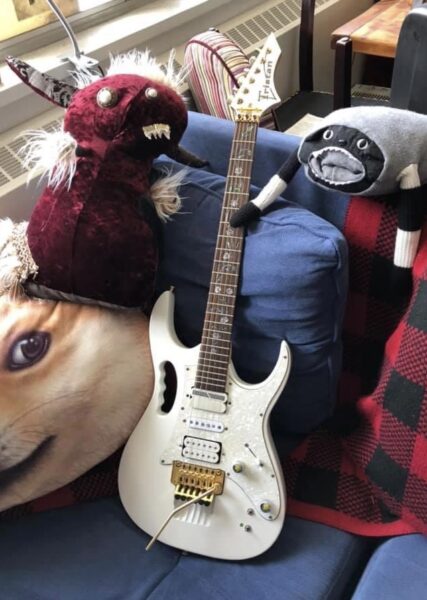
PRS gifted me a Tremonti, basically a single cut with high output ceramics, and I love it. It’s a More Paul. When I need a modern, heavier sounding Les Paul, I grab it. Plays like butter. The wraptail makes playing power chords feel like throwing lightning bolts from Mount Olympus – ridiculously punchy – and gives you crazy sustain. Plus, those hot-ass pickups clean up magically from the volume knob. Unreal.

Special mention has to go to Godin/Seagull/La Patrie, a Canadian company that makes excellent North American made and sourced guitars at an affordable price point. A ridiculously wide range of guitar types – they were my go to company as a theatre musician, a job that requires versatility. When I got hired to do a show, I’d look at the „book“, and if it demanded something I didn’t own, I’d look at their website, and sure enough… they had it. No other company has quite as diverse a product roster. Most of my acoustics and a couple of my weirdies are theirs.
What do you think makes the perfect guitar and amp?
It’s about finding the right pairing. Gibson/Marshall is a no-brainer. So is Fender/Vox (or Fender/Fender, for that matter). But experimentation yields the best results – and it might not be the combination you’d expect.
A transparent overdrive pedal is invaluable. My grey DOD 250 from the 70s added just the right amount of gain to bring out the best in both components. I had it for years, and thought it was garbage – not enough gain. I didn’t realize what it was actually for until I finally put it between the right guitar and the right amp. It makes an already good combination come alive. But you don’t need a vintage OD. The vintage pedal market has skyrocketed, along with prices. And there are so many new OD pedals on the market at every price point that it’s literally bewildering. Find a good one and play around with it until you’re „home“.
If you NEED vintage, you need therapy, haha. I get it, but there are so many more options now. Boutique has blown things wide open. Many guitar, amp and pedal builders are incorporating the best of vintage without the flaws and inconsistencies. Of course, „flaws“ sometimes create character, but for a working musician, quality and good design usually win. Guitars made in the 90s, even the 2000s, are „vintage“ now, and still relatively affordable. I have a ’91 Japanese „Orville by Gibson“ ES335 „dot“ that’s as good as one from Gibson Memphis, at less than half the price. Keep an open mind, if possible.
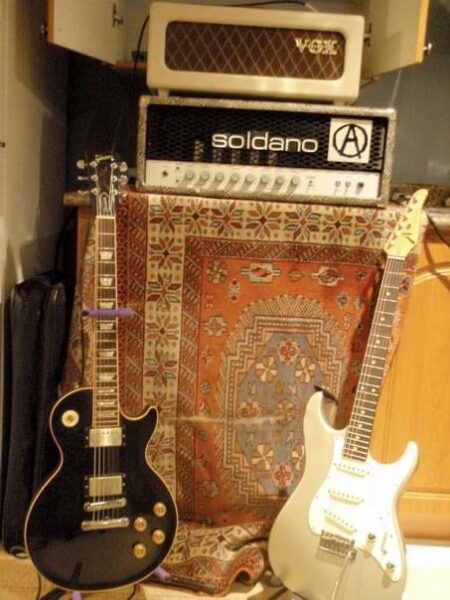
How do you feel about the question of modeler or tube amp?
I miss my SLO 100… the overdrive channel is the gold standard for high gain, and the crunch channel is a Plexi killer. But it had only been taken out of the house a dozen times or so in the last 15 years. Too loud, not to mention too big and heavy. So it had to go. It was just sitting there looking pretty and tying up money.
It’s too bad. I miss my handwired Vox AC15 too. The EF86 channel, especially, was magic. But they both need to be turned up loud and pushed hard, and even stepped down with a THD Hotplate, they’d knock the pictures off the walls.
And then you may have to carry it when you play out. I miss feeling the big bastard vibrating every cell of my body, and leaning into the breeze… but i don’t miss picking it up and humping it up stairs afterwards, that’s for sure. Unless you have backline or a road crew, forget it.
You can get an Ox box or the Waza Craft amp expander for recording your amps direct, but they cost nearly as much as a modeller with 100 amps in it.
And the modellers and plugins are spectacular now. I started using Tech21’s SansAmp products as soon as they were available, and still do – Andy Barta is a genius. I went Fractal long ago. No stage volume, great tone and flexibility, dead reliable. And I’m using Neural’s Quad Cortex exclusively for live. With the right amp capture it’s everything that I need for Marc Martel’s One Vision of Queen, and it fits in my gig bag. We do fly ins, mostly, so that’s handy… I can literally just walk off a plane and go do the gig.
For recording, Neural’s plug-ins are more convenient than an amp. Their SLO 100 plugin is 90% of the real thing, with no hassles. Both their products, the QC and the plug-ins, are super easy for guitar players. Much simpler than the Fractal stuff – which is very flexible, but you need the software editor.
I’ve always had fun with effect chains and I even played synth for a while, so I’m not as phobic about programming as some classic rock guys. I can literally make two very different guitars sound the same. I can sound just like your favorite classics, comfortingly familiar. Or disturbing… an alien choir, the call of the Elder Gods…. strange, unearthly. Something you can’t even identify as guitar. And I love that.
I do miss the speaker thing, especially the freedom to make things sound unique with different mics, placement, phase, distance… plug-ins don’t really do that. Sorry, a picture can’t replace physical reality. So it’s becoming a lost art. But recording budgets nowadays simply don’t justify having the whole armoury of amps, cabinets and mics readily available. For better or worse, plug-ins are the only sane option.
When I see YouTubers – I’m not gonna name names – in their impressive studio cockpits bristling with every piece of iconic guitar gear, every desirable classic tone imaginable at their fingertips, I have to wonder how they make a living. Are they actually working on real records or catering to a boomer fantasy of a bygone age?
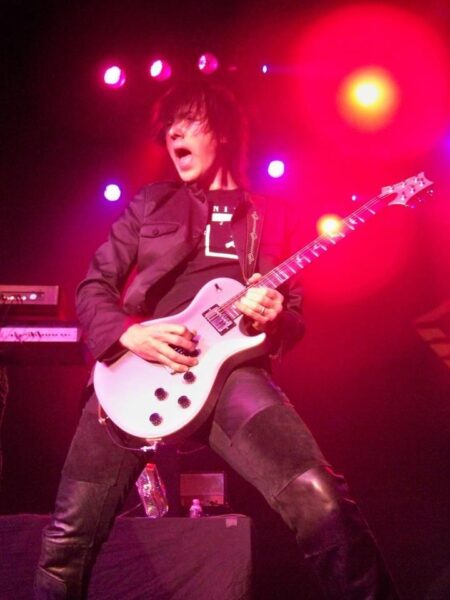
Which guitars and amps were used on the new album or for recordings?
For the Killer Kings album (now available on Frontiers SRL https://orcd.co/killerkings), I wanted to be as colourful and stylistically diverse as the genre will allow, and push the boundaries whenever possible. So I used a variety of guitars. The „Chi-banez“ for technical, high velocity shred, the PRS Tremonti for most of the heavy rhythms and a few leads, the Les Paul on songs that demanded a more „classic rock“ sound. A Les Paul Junior DC Tribute for gutsy rhythms and slide, a Danelectro makes a brief appearance for a Zep moment, the BMG for Queen-y accents.
Of course, the Anderson Classic for the Strat thing – anything bluesy, vocal: Hendrix-y, Blackmoreish, Gilmouresque. And on the clean stuff it delivered in spades.
A Takamine nylon and a Seagull Artist rounded things out for acoustic. Both have excellent electronics – no need to mic them.
No amps were used, only plugins – mostly Neural: the Cali Suite for heavy rhythms, the Archetype Petrucci and SLO 100 for leads. The Tone King MK II was great for the edge of breakup tones.
The Amplitube Brian May bundle did the trick for that Queen thing, and their 57 Deluxe, with their tube compression and tri-stereo chorus clone, was great for the clean stuff.
When you only can choose one guitar, which one will you take?
The Anderson Classic. It is by far the most versatile instrument I own. A good Strat will cover anything with a little tweaking, and Tom makes the best one there is.
They are absolutely killing it right now. They’ve diversified their product line tremendously and are offering more body styles, finishes and hardware options than ever. They are right in the sweet spot between tradition and innovation. And no guitar plays better, period. An Anderson practically plays itself. If I could afford it, I’d buy one of everything they make.

